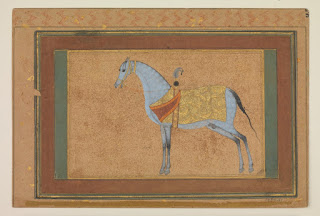The Ashmolean Museum in Oxford turned down the complete collection, valued at £7.2 million, due to concerns over the works’ provenance.
by Cassie Packard
Habiballah of Sava, "A Stallion" (c.
1601-1606), formerly in the collection of Howard Hodgkin. In addition to the
potential impending acquisition of Hodgkin's collection, the Met already owns
several artworks previously belonging to, or purchased with funds from,
Hodgkin. (courtesy the Met's Open Access Policy)
In a 1991 essay on the development of his personal art collection, British painter and printmaker Sir Howard Hodgkin recalled his first purchase of an Indian work of art, a colorful depiction of people lounging in a garden painted in Aurangabad in the 17th century. “I must have been about fourteen years old,” Hodgkin wrote. “I have no recollection of how I paid for it.” He remembered that he had tried betting on horses at the race track to raise the requisite funds, but lost.
Though it didn’t stay in Hodgkin’s collection for long, that early acquisition marked an important first step in the artist’s lifelong commitment to collecting Indian art and his passion for the country itself. Hodgkin, a Turner Prize winner renowned for his vividly pigmented abstractions, said that India “changed my way of thinking and probably, the way I paint.” (In 1992, he was also commissioned to paint a large mural for the British Council building in New Delhi.)
When he died in 2017 at the age of 84, Hodgkin left behind a collection of over 115 Indian paintings and drawings from the 16th to 19th centuries, with a particular emphasis on Mughal art — art from India’s last Islamic dynasty — which emerged in conversation with Persian miniature painting and flourished in court ateliers, perhaps most famously, that of Akbar.
Hodgkin’s varied holdings, which he said were led by an artistic eye, rather than a scholarly one, include a large-scale Kota painting of a royal hunting trip with tigers and lion as prey; a Deccani illumination of a vase, which is an ancient fertility motif in Indian art; and an intricate 17th-century painting of a wedding procession, led by a man on an elephant, cutting through a bazaar. Hodgkin was quite partial to depictions of elephants, writing in 1983 that “good Indian drawings of elephants are more frequently encountered than any other subject,” perhaps due to the animals’ shifting volumes and surfaces.
Hodgkin had hoped that his beloved collection, which is said to be valued at over £7.2 million (~$9.9 million), would be transferred in its entirety to the Ashmolean Museum in Oxford. The Ashmolean, which presented Hodgkin’s collection in an exhibition titled Visions of Mughal India in 2012, has the most comprehensive holdings of objects from the Indian subcontinent of any British museum outside of London, including numerous examples of Mughal art.
However, a source told the Guardian that the Ashmolean turned down the collection due to concerns over the works’ provenance. “One funding body warned the museum privately that, without proof of certain works having left India entirely legally, it would not offer a grant towards the purchase and future grants could also be affected if the museum acquired it anyway,” the British news outlet reported.
Hodgkin’s longtime partner, the music critic Antony Peattie, explained that Hodgkin bought art from international dealers without posing questions about the works’ path from India. “The priorities when Howard was collecting in the 1970s, 1980s and 1990s were quality, not provenance,” Peattie said.
Andrew Topsfield, an honorary curator at the Ashmolean with a specialty in art from the Mughal period, determined that 40% of the works on offer had “clear and secure,” fully documented provenance that demonstrated that the works had left India legally. While the museum expressed interest in acquiring only this group of sanctioned works, Hodgkin had always wanted the collection to stay together, viewing it as an autonomous entity of sorts. The deal didn’t go through.
Now, the Guardian has revealed that the Metropolitan Museum of Art in New York is considering acquiring Hodgkin’s collection, despite the provenance questions that gave the Ashmolean qualms. Peattie confirmed that the acquisition was under discussion at the Met, but made clear that “nothing’s settled.” The Met, the article said, declined to comment. (The museum has not responded to Hyperallergic’s immediate request for comment.)
In addition to having over a dozen works by
Hodgkin himself in its permanent collection, the Met also already owns several
artworks previously belonging to, or purchased with funds from, Hodgkin,
including a painting of a stallion (c. 1601-6) from present-day Afghanistan, an
album page with Christian subjects from the late 16th century, and a
17th-century painting of preparations for a hunt, among others.
https://hyperallergic.com/639390/indian-art-collection-of-howard-hodgkin-may-find-a-home-at-the-met-despite-provenance-concerns/?utm_campaign=daily&utm_content=20210423&utm_medium=email&utm_source=newsletter

No hay comentarios:
Publicar un comentario